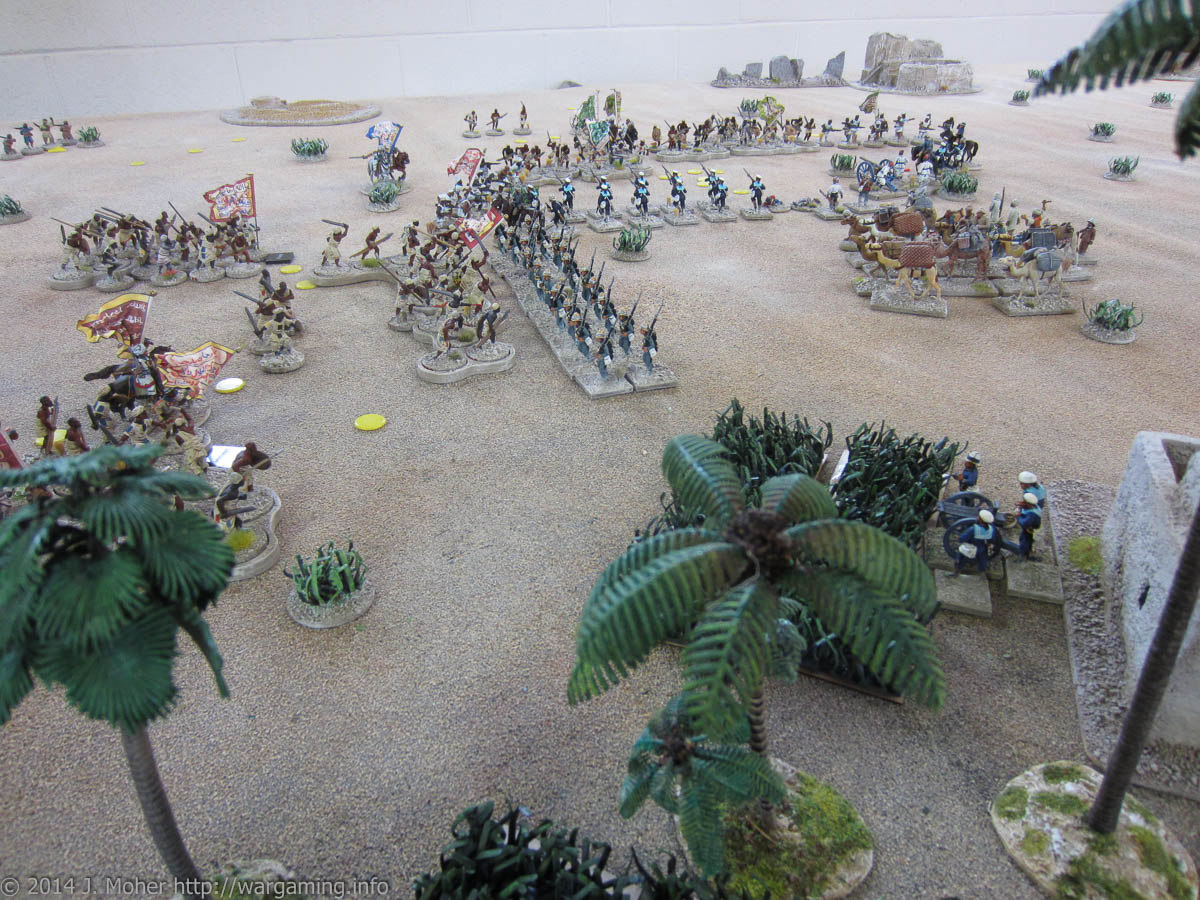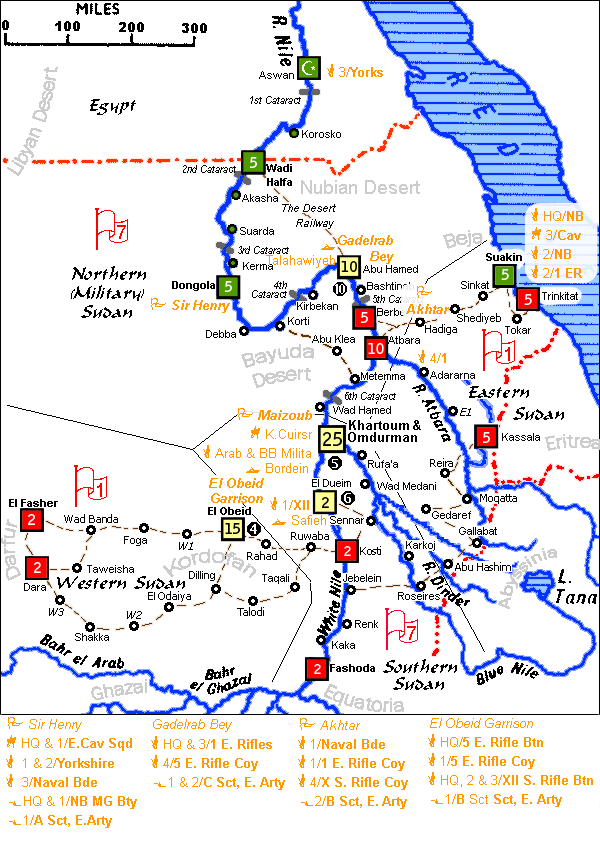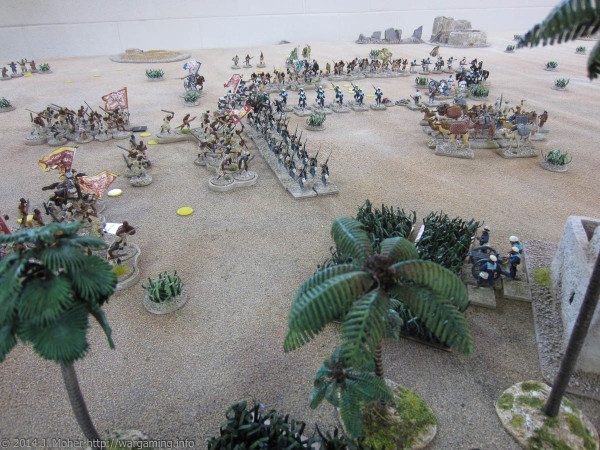After the rather erratic results in February 1884 the Anglo-Egyptian forces were facing some great challenges (and some perhaps unrecognised opportunities) in March. Both Eastern & Western Sudan are only showing very low levels of rebellion and not offering a serious threat to the Anglo-Egyptians – the real fight for Sudan is spread the length of the Nile, from Fashoda all the way downstream to Abu Hamed. In the North the 3rd Company, 19th Yorkshire Regiment headed south from Aswan to Wadi Halfa ready to move into the Sudan in April; where it is joined by a late reinforcement in the form of a company of the Egyptian Camel Corps and a Screw Gun Battery of the British Camel Corps.
At Dongola Sir Henry reorganised his force, including the assorted civilians present that he had liberated in the town, and prepared to push on South as soon as possible. At Abu Hamed, Kaimakam Khatib Gadelrab Bey decided the time was right to force matters with the Mahdists, and sallied forth hoping to break the siege and potentially march on Berber (not being yet aware of Akhtar Bey’s repulse there a few weeks earlier).
Readers can download a PDF of the Revolt In The Sudan OOB March 1884 for a more detailed list & dispositions of the Anglo-Egyptian force.
In the East Akhtar Pasha turned his force around and headed back West to the Nile, this time aiming for the Fort at Atbara, which unknown to him the 4th Company, 1st Egyptian Rifle Battalion was also approaching independently in it’s trek down the Atbara River! In Suakin Captain Finnán Lawrence dispatched a portion of his force to neighbouring Trinkitat to retake the fishing town and re-establish a garrison there, while separately sending the Egyptian Cavalry to the West in search of Akhtar Bey’s force.
In Khartoum Maizoub Bey prepares to send the valiant Bordein forth again while further South Safieh also prepares to set forth, and in El Obeid the acting garrison commander Mulazim Jassim Musalem Effendi (5th Egyptian Rifle Battalion) prepares to dispatch the XIIth Sudanese Battalion (of 2 Companies) in a breakout and march East to Kosti on the Nile. This is the situation in the first days of March as the Revolt in the Sudan continues to unfold…
On the Red Sea Captain Lawrence’s force rapidly recaptures and re-garrisons Trinkitat, as the Egyptian 3rd Cavalry Squadron disappears west into the Beja desert – in both instances there is little sign of the rebellious Fuzzy-Wuzzy tribesmen… With the arrival of the reinforcements from Alexandria in February Suakin is now firmly established as the base for the second thrust to Khartoum and as has been the case in the North it guarantees a steady stream of supplies with Egyptian Gendarmes and similar available to help maintain control of the reconquered territory and liberated towns; freeing the fighting troops from garrison duties to more actively participate in the reconquest.
In Dongola, Sir Henry compiles his column and prepares to set out – the 19th Yorkshires are reorganised into 2 composite companies – one contains all the wounded under the 1st Company’s senior NCO Sergeant Filib Abramson (1/3 of a company) and will remain at Dongola to convalesce – the remainder under the 2nd Company’s Lieutenant Huronoby-Middlegood (numbering 2/3 of a company in total) will advance with the column. Also present with Sir Henry’s column are some of the civilians liberated in the town, including some Egyptian Artillerymen who join Zulfakar’s artillery section to bring it back up to full strength in gunners, a couple of European Adventurers, and a local Shaigiya Sheikh who is so pleased at the Mahdists being turfed out of town he insists on coming along with his most loyal followers to repay the debt! Sir Henry’s column heads up the Nile, to Debba on the great bend, and are soon engaged by the Dervish forces in the area!
At Abu Hamed Gadelrab Bey sallies forth against what appears to be fairly weak opposition – or at least it appears so – hoping to send a force to march on Berber. In Eastern Sudan Akhtar’s march on Atbara finds him facing a well fortified and fairly large force of Dervishes & Fuzzy-Wuzzies! As Akhtar Pasha ponders his plans in his improvised zeriba fortified camp a couple of miles from Fort Atbara the Dervishes boldly elect to attack, and Akhtar’s column are soon fighting for their lives! At the same time unknown to Akhtar, the 4th Company, 1st Egyptian Battalion is somewhere near Atbara as well, approaching from upriver, oblivious to the battle North of them!
Out in Kordofan the forces at El Obeid under Musalem Effendi sally forth, opposed by only a skeleton force of besiegers (with no rifles or artillery) they quickly clear the immediate surrounds, and an expeditionary force of the XIIth Sudanese Battalion under Mulazim Madathal Shanawani Effendi heads East to the Nile. With 2 companies of his Sudanese Battalion, a ½ company of the 5th Egyptian Battalion, and the 1st Section, B Battery, Egyptian Artillery his relatively powerful force marches to Rahad unmolested before crossing into Southern Sudan where it is attacked my mobile Mahdist forces en-route to Ruwaba.
In Southern Sudan Safieh set sail from El Dueim up the White Nile to Kosti – to reconnoitre for Dervishes and forage for supplies for the garrisons at El Dueim & Khartoum. At Khartoum itself the defenders continue gathering what remaining resources they have to strengthen the defences as Maizoub Bey sends the Bordein down river – North to look for sign of a relief column…
Be sure to check back in the future for more updates to this post as the various March 1884 battles and expeditions are resolved and the updates or battle reports posted!
If you have not seen my Fire & Sword “Revolt in the Sudan” Campaign previously you can start from the beginning here.



Really enjoy reading all about your campaign in the Sudan. It made we dig out my old copy of The Sword and the Flame as well as my Sudan range of minis (all Essex from 1985). I have had a blast getting them back out on the table. Just wandering if you ever plan to finish the campaign?
Thanks Stephen – still trying to get back to it and get a few more turns and battles played – unfortunately real life has not been cooperative. Armies are keen to get out of their boxes again!